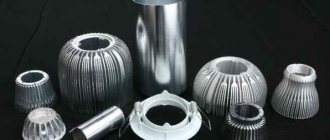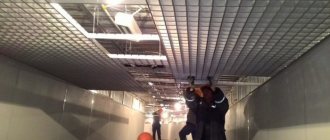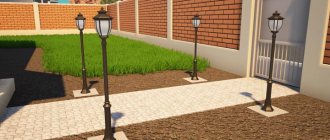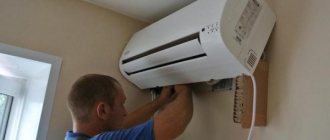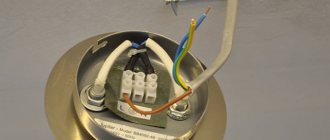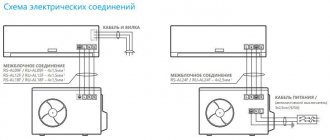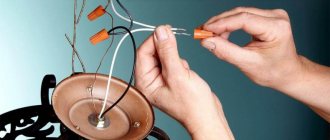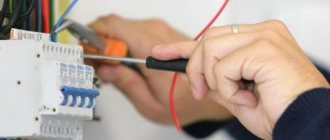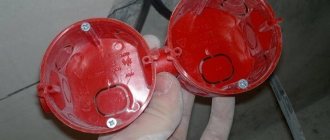LED products appeared on the market several years ago, becoming a real breakthrough in lighting technology. These versatile, durable and reliable devices are characterized by many other advantages, including high efficiency and versatility.
It's no surprise that people are wondering how to connect an LED floodlight. After all, the devices are used at administrative and industrial facilities, for decorative lighting of summer cottages, gardens and the interior of country houses.
Performing these steps requires a certain level of electrical knowledge. Professional installers do not recommend connecting LED spotlights yourself, as this can lead to problems and complete failure of the soffit. However, if you act carefully and take responsibility at every stage, the result will be positive.
Step-by-step instructions for connecting an LED spotlight
LED lighting products are distinguished by their versatility, durability, reliability, versatility and efficiency.
They became a real breakthrough in the field of lighting technology. LED spotlights can be used for indoor and outdoor lighting.
By following the step-by-step instructions, you can connect and install the lighting device yourself.
Connection diagram
The floodlight for connecting the network has an input coupling for the cable and a terminal socket with three wires - phase, neutral, ground. Before connecting the wires correctly, you need to check their markings. Conductors are letter or color coded.
Phase wire (L) is red or brown, zero (N) is blue or black. Wires are pulled through the hole in the housing. It is necessary to connect plus to plus (phase wires), minus to minus (neutral wires) and ground.
If a sensor is provided in the LED spotlight connection diagram, two wires, plus and minus, are connected to it.
Necessary equipment and materials
To connect the spotlight you will need:
- side cutters;
- knife for stripping wire insulation;
- soldering iron;
- insulating tape;
- screwdriver;
- screwdriver;
- wires.
Since the power of the LED spotlight is low, you can choose a thin wire of 1 - 1.5 sq. mm. For powerful devices, it is better to take a wire with a cross-section of 2 sq. mm.
Important! The wire must be selected from the same material as on the spotlight
Step by step procedure
First of all, if you purchased an inexpensive device from a little-known manufacturer, it is advisable to disassemble it and inspect it. There should be no visible damage, unconnected wires, or lack of insulation.
Basic steps for installing an LED spotlight:
- removing the terminal block fastening;
- stripping the ends of wires;
- input of network electrical wires;
- connecting power wires;
- securing the cover;
- installing an LED spotlight on a bracket;
- installation of the assembled structure on the desired site.
The connected wires must be stripped of 2-4 cm of insulation.
Connection procedure with and without grounding
Before connecting the spotlight, be sure to read the instructions. If the polarity is not indicated, it can be ignored when connecting to the network. To install the spotlight, a flexible copper conductor that is resistant to high temperatures is used.
It is not always necessary to connect the insulating wire. For example, if the supply wire has a two-core design. Then the ground can be insulated and hidden in the device.
To ensure trouble-free operation, step-down transformers are additionally used.
Features of connecting an LED spotlight with a motion sensor
Models with a motion sensor are very popular. They work when moving near the sensor, so there is additional energy savings.
The motion sensor is an ultrasonic module with a relay. When movement occurs in the visual range, the relay closes, power is supplied and the lighting device turns on.
Additionally, you can set the time in the sensor after which the power will turn off if there is no movement within the range. You can also mount a classic switch in parallel if the sensor fails.
Main conclusions
LED spotlights are reliable devices for creating outdoor and indoor lighting.
They can be equipped with both minimal functionality and additional options that simplify work.
You can connect the spotlight yourself by following the instructions. In order to connect it to the network you need a minimum set of tools.
PreviousNext
Required tools and materials
To connect the lamp you will need the usual electrical tools:
- wire cutters for cutting power cables;
- installer's knife for stripping cable sections;
- a screwdriver for connecting the wire ends to the terminals.
Electrical wire cutters.
This is enough to make the connection. But a professional would also advise:
- special insulation stripper;
- lugs for wires of the appropriate diameter and crimping tool.
If the installation is carried out with multi-core wire, it is a good idea to tin the stripped areas - a soldering iron is useful for this.
And, of course, you need an electrical cable of the appropriate cross-section. For a voltage of 220 V, it can be selected from the table in accordance with the power of the spotlight:
| Conductor cross-section, sq. mm | 1 | 1,5 | 2,5 | 4 |
| Load power for copper conductor, W | 3000 | 3300 | 4600 | 5900 |
| Load power for aluminum conductor, W | — | — | 3500 | 4600 |
Important! When choosing a cable, you must take into account the power consumption of the lamp, and not the equivalent power (corresponding to the power of an incandescent lamp).
Installation recommendations
When connecting the spotlight, it is advisable to use a cable with standard core insulation colors and follow the connection order.
Cable for connecting a single-phase load with a grounding conductor.
- the red wire is connected to the phase terminal (L);
- blue – to zero (N);
- yellow-green – to ground (PE).
This order must be observed both on the side of the power source and on the consumer side (luminaire). Of course, for electric current, the color of the core does not matter, and if the connection is not made correctly by coloring the insulation, nothing will happen - the spotlight will work just as well. But compliance with the rules speaks about the professionalism of the installer. And in the future, if repairs or reconnection are necessary, it will be easier for another technician to understand the circuit.
If the wiring runs along the street, in order to ensure anti-vandalism, it makes sense to lay it in pipes. In this case, you need to understand that the conditions for heat removal will be worse than in the version with an open gasket. If, according to calculations, it turns out that the load power is close to the upper limit for the selected cross-section, then the diameter of the wire must be increased by at least one step. In this case, it is even more correct to clarify the parameters of the conductors in the PUE.
Installation of electrical wiring in a metal pipe.
How do experienced electricians carry out installation?
Before moving on to the details of the issue, it is necessary to understand what the inside of the spotlight is. The convex part located on the back of the flashlight is a box with terminals. It is this mechanism that serves to connect the device to the network. The important thing here is to know what each individual detail means. Let's proceed to the instructions for proper installation.
What does an LED street floodlight look like?
- First of all, we open the case, that is, we get close to the working mechanism of the spotlight.
- Remove the nut on the “input” terminal and take out the oil seal.
- We thread the electrical cable and cover all the terminals with fasteners.
At first glance, the question of how to connect a spotlight has completely simple answers and involves short-term actions, however, this is another misconception, because it is very important to monitor every movement and connect zero, phase and grounding according to the rules and in the right order.
Attention! At the last stage of connecting the flashlight to the electrical network, it is important to seal the housing hermetically.
Three-wire motion sensor connection diagram
Three terminal sensors are typically used in IR sensor type designs. A fairly common manufacturer of inexpensive infrared motion sensors is IEK. You can find good products on Aliexpress without any problems.
More expensive products are made according to a similar principle; the connection diagram for a lamp with a sensor is similar for a sensor model from any manufacturer. Devices must have a degree of protection IP44 against penetration of solid objects greater than 1 mm and drops of moisture. If the motion sensor needs to be moved outside the house, then installation is only possible under a canopy.
If you want to protect the device from rain and snow, look for a model with IP65 dust and moisture protection and a temperature rating for your climate. Most IR sensors can only operate down to minus 20 degrees Celsius.
To connect a three-wire IR motion sensor, a full phase and zero are started. For correct placement you will need the same basic 4 elements:
- Circuit breaker (which is in the switchboard).
- Distribution box (in which the main installation).
- Sensor (a wire from the junction box is connected to it).
- Lamp (second wire from the junction box).
The sensor is connected with three wires to the factory in the distribution box of three cables:
- There are three wires from the machine: L (phase), N (working zero), protective zero or ground (PE).
- There are three wires per lamp if the body of the lighting fixture is made of metal.
- Three wires per sensor.
How to connect a motion sensor to a light bulb using three wires is discussed in detail in the diagram.
The zeros (N) are collected at one point (as in the case of the previous diagram). The ground from the circuit breaker is also connected to the luminaire ground (zero drive or PE). The motion sensor with three terminals is now supplied with phase-zero:
- Two input ones are for 220V power supply, usually labeled as L (phase) and N (zero).
- One output is designated by the letter A.
Installation
To install a three-wire motion sensor:
- Unscrew the two screws in the housing. The terminals are located under the back cover.
- Some models are already led out of the housing by three wires of different colors. By color you can determine what it means: ground (A) red, zero (N) blue, phase (L) brown. But if the cover opens without much effort, it is recommended to verify the correctness of certain markings in person by looking at the inscriptions next to the terminals.
- A simplified diagram of connecting a motion sensor to a light bulb looks like this:
- A little clarity in this picture.
- You can do without a junction box for connecting wires and run all the wires directly into the sensor box, if the inside is spacious enough and has its own terminal block. Phase-zero was supplied from one cable, and phase-zero was removed from the other.
- The result is a simplified, but the same three-wire circuit, only without a junction box.
Setting and adjusting sensitivity
After successfully connecting a lamp with a motion sensor, you need to set its parameters correctly:
- On the back of the case, find the main controls. LUX with the positions of the month and the sun is responsible for triggering depending on the illumination. Do you need the sensor to turn on in a room with a window only when it is cloudy or the sun goes down? Turn the regulator towards the moon.
- Use the second regulator to set the shutdown time. The delay can be set from a few seconds to 5-10 minutes.
- The rotation angle of the entire sphere allows you to adjust the detection of animals.
Advantages and nuances of use
To prevent the sensor from reacting to animals, do not turn the sensor head down towards the floor. Position it so that it captures the movements at the level of the head (shoulders) of all residents of the house. Typically, animal capture does not occur at this level.
If you need the sensor to temporarily not work, then point its head at the ceiling. Therefore, motion capture is not possible. The sensor's motion capture depends on the angle of inclination. In reality, the maximum distance reaches 9 meters. But according to the passport it may be higher.
The sensor uses infrared rays for detection. If you move from beam to beam, the device notices activity and reacts. When you walk directly into the beam, the sensitivity of the sensor is minimal and the device may not immediately respond to you.
For this reason, motion sensors are installed not directly above the doorway, but slightly to the side. For example, in the corner of the room.
Flaws
The disadvantage of the three-wire circuit for connecting the motion sensor to the lamp is that the light does not turn on forcibly. If the sensor malfunctions for some reason, problems will begin with its correct operation. To avoid this, it is recommended to add a switch to the circuit.
How can you adjust the detector?
In modern motion sensors (MS), you can adjust the sensitivity, illumination, delay time for turning off the light and installation angle.
All these parameters, when properly configured, can save up to 50% of energy, which is a very significant figure. However, it should be immediately noted that not all motion sensors have three controls. In older models, you can adjust only two parameters - delay time and sensitivity, or delay time and light level, as in the photo below:
Now we will look separately at how to set up a motion sensor on a spotlight or other type of lamp.
Diagram of connecting the driver to the LEDs
Connecting the driver to the LEDs is simple, anyone can do it. All markings are applied to its body. You apply input voltage to the input wires (INPUT), and connect a line of LEDs to the output wires (OUTPUT). The only thing is that it is necessary to maintain polarity, and I will dwell on this in more detail.
Input Polarity (INPUT)
If the voltage supplying the driver is constant, then the pin marked with the “+” sign must be connected to the positive pole of the power source
If the voltage is alternating, then pay attention to the markings of the input wires. The following options are possible:
- Marking “L” and “N”: a phase must be applied to the “L” terminal (located using an indicator screwdriver), and a zero must be applied to the “N” terminal.
- Marking “~”, “AC” or absent: polarity does not need to be observed.
Output polarity (OUTPUT)
Polarity is always observed here! The positive wire is connected to the anode of the first LED, the negative wire to the cathode of the last. The LEDs themselves are connected to each other: the anode of the next one to the cathode of the previous one.
Diagram of connecting the driver to a garland of three LEDs connected in series
If you have a lot of LEDs (say, 12 pieces), then they will have to be divided into several identical groups, and these groups will have to be connected in parallel. Please note that the total power consumed by the luminaire will be the sum of the powers of all groups, and the operating voltage will correspond to the voltage of one group.
With this connection method, the currents of all four groups of LEDs are added
A few important rules
For safety reasons, it is very important to adhere to several rules when working with electricity:
- All work related to connecting electrical appliances should be carried out with the circuit breaker located on the panel turned off. Remember - there must be no power on the cables.
- To check the voltage, you must use an indicator screwdriver.
- When working, it is very important not to confuse the alternating current connection: “zero” should be connected only to the neutral cable, “phase” to the phase cable.
- After completing all the work, you need to connect to the power supply and check the functionality of the installed and connected system. In addition, you should configure the motion sensor.
Electrical connection
To connect most lighting devices to a single-phase 220 V network, they are equipped with three terminals:
- phase (denoted by L);
- neutral conductor (N);
- grounding conductor ().
Obviously, the connection must be made using an electrical network with TNS neutral mode. The peculiarity of this mode is that it consists of phase conductors, neutral (N) and protective (PE). In this case, the connection diagram for an LED spotlight with three wires is simple - phase conductor to phase, neutral to neutral, grounding to PE. The same applies to the TNC-S system. In it, the neutral and protective conductors are separated at a certain point, usually at the entrance to the building. But many networks are made according to the outdated TNC scheme, where the neutral and protective conductors are combined.
In accordance with the rules, in these networks it is necessary to use lighting devices that do not require grounding. Such devices include devices with the following protection class:
- 0 – protection is provided by one layer of insulation, the least safe option;
- II – devices with double or reinforced insulation are noticeably more expensive;
- III - devices powered by ultra-low safe voltage (below 50 V AC), they are beyond the scope of this article.
Important! The protection class of an electrical appliance can be determined by its passport, technical specifications or markings:
- 0 – not marked;
- I – grounding symbol or the very presence of a grounding terminal;
- II – double insulation icon;
- III – Class III protection badge.
In class II devices, safety is ensured by the presence of protective grounding, and their use in a TNC network without grounding is contrary to the rules and can lead to dire consequences if the main insulation is broken and voltage appears on the luminaire body. It is also contrary to the PUE to connect the grounding terminal to the working neutral conductor (N, PEN).
At his own peril and risk, an electrician can connect a device of protection class II without connecting to the protective ground. And the spotlight will even work. But he must remember that the consequences will be on his conscience. He may even have to answer to the law.
Features of connecting 12V lamps
To correctly connect LED lamps with an operating rating of 12V to a network with a voltage of 220V, you need to take into account several factors:
- Household current has a variable value; low-voltage ice elements require constant current. Therefore, at the beginning of the circuit you will need to install a special transformer.
- Before purchasing a voltage-reducing module, you need to correctly calculate its power. To do this, the exact number of 12-volt LED lamps used and their total power are calculated. For example, if their number is 5, 10 W each, then the total required power is 50 W. In this case, a 20% buffer is necessarily added to the calculated value. In this case it is 10 W. Thus, the total power of the transformer must be at least 60 W.
- If you do not have enough experience, do not try to assemble the step-down module yourself. For maximum safety and reliability, it is better to purchase a factory device with guaranteed characteristics and service life.
You can connect 12V LED lamps to a 220V network using the mechanisms described above - parallel and serial. In the first case, it is necessary to use a step-down and rectifying transformer, since the same constant voltage will be supplied to each lamp. It's another matter when all the devices are connected one after another.
Important! Despite the fact that in low-voltage led elements in a series circuit the entire voltage in the 220V network is distributed, the current value remains variable. Therefore, you will need to install a rectifier
With its help, a plus will be supplied to one end of the chain of LED lamps, and a minus to the other.
For those who have good experience in radio engineering, assembling a buck-rectifying device is not particularly difficult. In order to connect 12V LED lamps to a 220V household network, two circuits are used:
- Simplified on a quenching capacitor.
- More stable with chip.
The first one is cheap and simple. Its main disadvantage is the possible pulsation of the light flux and inaccurate parameters of electronic components. The second version reduces the disadvantages of the above to nothing. However, it is more complex in design and more expensive, but at the same time more stable and reliable.
When choosing a location for installing a transformer, rectifier and other electrical devices, it is necessary to take into account the ambient humidity. If their contact with water cannot be avoided, it is better to purchase models with a waterproof, sealed case.
Safety precautions and operating rules
When doing any work with electrical installations, the main rule must be observed - all actions must be performed with the power turned off. The absence of voltage must be checked with a pointer directly at the place of work. The electric tool must be in good working order and have no damage to the insulation. Even better, even at home, use protective equipment against electric shock - dielectric gloves, carpets, galoshes. There are never too many security measures.
During operation, it is also necessary to monitor the integrity of the insulation of wiring and switching equipment. In case of any damage, the lighting device must be taken out of service until the fault is eliminated.
Electric shock protection classes
According to section 7 of GOST IEC 61140-2012 “Protection against electric shock. General safety provisions for installations and equipment"
, protection against electric shock is provided by the design measures applied to electrical equipment and devices, together with the methods of their installation.
Depending on the method of providing protection, devices are classified into classes from 0 to III. Let's consider them in more detail - as applied specifically to lamps as described in GOST R IEC 60598-1-2011 “Lamps.
Part 1. General requirements and test methods" . But first, a few more definitions:
We connect the LED spotlight with our own hands
The connection diagram for a floodlight based on LEDs will vary depending on the elements of the circuit, for example, if you need to additionally install a motion or light sensor. The process of installing a light source of this type is not particularly difficult.
Design features
The design of such a lighting device includes several elements: LED lamps, a bracket, a control unit consisting of a sealed housing, a controller and a battery or board, which is used in stationary models.
Reliable operation of the device is ensured by a controller that regulates the LED spotlight using time relays and automatic switches that perform a protective function.
Such light sources are controlled in two ways: manually through switching devices, automatically due to the presence of a control unit that responds to changes in light intensity or to the movement of an object within its range.
The LED spotlight provides glow due to design features that recreate the process of recombination of electrons and holes located in the region of the pn junction. The basis of the operation of such light sources is the contact of semiconductors characterized by different types of conductivity.
Spotlight connection diagram
To insert the power cable into the terminal box, you need to open it by removing the fastening connection. To ensure the tightness of all connections, a gland is provided through which the power cable is routed.
The connection diagram for a 220 V network is as follows:
If you need to connect an automatic control unit in the form of a motion sensor, use this option:
For normal operation of the lighting system, it is necessary to configure the motion sensor in three directions: sensitivity level, photosensitivity and operating time regulator.
Stage-by-stage execution of work
The spotlight can be located in an accessible area, however, most often, to ensure safety, such lighting devices are installed at a sufficient height. Therefore, it is recommended that all connections be made before the device is mounted on the bracket.
Basic actions:
- Removing the terminal box fastening;
- Inserting the power cable into the gland and then connecting it to the terminal block;
- The box lid is closed;
- The spotlight is mounted on a bracket;
- The entire structure is installed in the area where the lighting device is planned to be used.
The bracket can be installed at any angle, for which the side screws of the fastenings are loosened in order to be able to adjust the direction of the light.
The process of connecting to the power grid
Connecting the spotlight to the network requires creating safe working conditions. To do this, there must be no phase on the connected cable.
The structure is hermetically closed after all elements of the circuit have been connected.
It is important to connect the three-wire wire correctly, for which you can follow the generally accepted colors: “zero” - blue or black wire; “earth” is almost always yellow-green; “phase” is the red or brown color of the wire. Installation of the spotlight and connection to the 220 V network is carried out using a circuit breaker
A sufficient level of safety can be provided by a machine characterized by such a parameter as a protection current that exceeds the power value of the light source several times
Installation of the spotlight and connection to the 220 V network is carried out using an automatic switch. A sufficient level of safety can be provided by a machine characterized by such a parameter as a protection current that exceeds the power of the light source several times.
Thus, it is quite possible to install and connect the spotlight to the electrical network yourself, if the contractor follows the safety recommendations. A lighting device of this type is installed on a bracket, and with the help of not fully tightened bolted connections it is possible to change the direction of the light beam.
The light source housing is hermetically sealed after installing the cable; in addition, it must be grounded. For this, a separate grounding conductor or a power cable conductor is used. Since such lighting devices are most often installed outdoors, it is necessary to ensure that the spotlight has a sufficient degree of protection (minimum IP54).
(9 3.89 out of 5) Loading...
How to connect an LED lamp to 220V
The main advantage of such lamps in comparison with those operating on 12 Volts is that they can be directly powered from a switch. As a result, no additional financial costs are required for the purchase of a power supply, and installation is also straightforward. There are several ways to install LED lamps:
- serial connection;
- parallel;
- radial
Each is used in different situations and has its own advantages and disadvantages.
Sequential
Serial connection is used when it is necessary to save cable footage, and there are no special requirements for the premises. The implementation will require several double or triple wires. No more than six LED bulbs can be installed in one circuit, otherwise the brightness will be low. If one lamp fails, you will have to check the functionality of each one in order to eliminate the breakdown.
The connection itself should not be difficult. A phase is drawn from the switch to the first lamp, then from the first switch the cable is pulled to the next device. A zero is laid to the last lamp, which comes from the distribution box.
If a mistake is made in the circuit and the power and zero are reversed, the lamps will be under constant voltage, which is unsafe.
Parallel
Parallel connection is more practical and is used more often. During the implementation process, each lamp will produce the brightness declared by the manufacturer. The only drawback that can be identified is the increased conductor consumption compared to a serial connection.
It is recommended to give preference to the VVG ng cable 2*1.5 or 3*1.5. The designation indicates the presence of a PVC shell - a high-quality insulating material. The marking indicates that the model is non-flammable. If there are special requirements for the room, sometimes wires with the additional marking “ls” are used, which means that a small amount of smoke is released when ignited.
To connect the lamp, a cable is pulled through the switch from the junction box. It is connected in turn to each lamp. After the first lamp, the cable is cut and fed to the next one until all devices are connected into one common system.
The advantage of the parallel connection method is that even if one lamp fails, the circuit will be fully operational.
Radial
By its nature, the beam circuit refers to a parallel connection, often used for chandeliers. The principle of implementation is to lay the cable to each lighting fixture individually. This method is the most labor-intensive and requires large financial costs due to the large amount of wire used. To save money, the cable from the distribution panel is routed to the center of the room and from there to each lamp. Next, single-core wires are connected to the phase and zero, which are laid to the lamps.
Even at the design stage, it is important to decide how the cores will be connected to a separate cable. If there are few lamps, twisting is enough
For safety reasons, it is securely crimped with pliers and welded together with a soldering iron. There is an alternative to this method - to purchase terminals with a certain number of outputs. A connector is put on each wire and only after that the wires are pulled to the lighting fixtures.
The connection diagram for LED lamps in all cases has no fundamental differences.
Stages of work execution
Work on installing and connecting diode spotlights is divided into three stages: searching for an installation site, preparing tools and materials, and direct connection.
Location determination
Here you need to move “from the end”: determine the area that should be illuminated by the spotlight, and then select the location for its installation so that the luminous flux falls on the desired area. Ideally, you need to make a diagram or draw a sketch. Make sure there are power sources nearby or route the wiring
It is important that the existing brackets are securely attached to the wall or selected object
Spotlights can be attached to the ceiling, supports, walls, and the main condition is the presence of a smooth surface for installation. The installation height depends on the dimensions and power of the product, the illuminated area, etc. It is recommended to mount small floodlights to a maximum height of no more than 16 m. Remember that these are multifunctional devices that allow you to easily set a specific angle of inclination.
Equipment and materials for connecting to the electrical network
During the work process you will need:
- side cutters;
- a stationery knife or a special tool for stripping wires;
- soldering iron with all accessories;
- insulating tape;
- screwdriver.
Connecting an LED spotlight with and without grounding
Read the instructions carefully. If it does not indicate anything about polarity, then you can ignore it when connecting to the network. To connect the spotlight, use flexible copper or any other conductor that is resistant to high temperatures (up to 160 degrees Celsius). There is not always a need for grounding, so you can simply insulate the yellow-green wire well and hide it in the back of the device.
Connecting a device to a particular network depends on the modification. These can be devices operating from a 220 V AC network, or equipment operating from 24 V DC sources. In the latter case, a regular household current rectifier can be used.
Before installation, inspect the body of the spotlight and make sure there are no visible mechanical damages. Free the terminal block by removing the cover to gain access to the terminals and ground connections. Unscrew the stuffing box and de-energize the room by turning off the power supply from the common distribution panel.
When replacing the spotlight with a new one, you need to throw away the old one, having first removed all the wires from it. It is advisable to select devices for which an identical mounting structure is suitable. Install the cover on an empty space - this element will protect the wires from water ingress.
Place the spotlight, attach the screws and bolts, remove the wires from the box and connect them to the required ones in accordance with the electrical diagram. Using a soldering iron, ensure secure fastening and good contact on the wires. Insulate, hide the connections inside the terminal box and replace the cover by tightening the bolts. Special latches can also be used for these purposes.
Tighten the screws on the floodlight to firmly attach it to the installation location. Apply power and make sure the light fixture is functioning.
Connecting 220 V lamps
Unlike a standard incandescent lamp, an LED lamp requires only DC power. Therefore, to connect it from a 220V household network, a special converter unit is required. Devices produced by modern manufacturers, designed for this rating, include a converter, so they can be plugged directly into an outlet.
There are three ways to connect LED lamps to a 220 V household network:
- Consistent.
- Parallel.
- Ray.
Each of them has its own installation features, pros and cons of application in various conditions and technical parameters. Let's look at them in detail.
Consistent
The sequential connection diagram for standard LED lamps intended for a 220V network involves connecting all lamps to each other with one conductor. The point is that a phase is supplied to the beginning of this chain, and a zero is supplied to its end. In this way, it is closed and each of the devices works in a common system.
The advantage of this serial connection is the ability to significantly save on wiring. To connect all lamps, a single-core wire is required, and if grounding is used in a 220V network, then a two-core cable, instead of a three-core cable. The disadvantage is that if one of the chandeliers burns out, the entire circuit will turn off, and you will need to search for the failed element to repair or replace it.
Algorithm for serial connection of an LED lamp:
- Install the lamps in accordance with the plan.
- Connect electrical lighting devices using serial wiring.
- Connect the conductor with the phase from the switch to the first chandelier.
- Lay a neutral conductor from the junction box to the last lighting fixture.
- Check the reliability and correctness of all wiring connections and complete the installation of electrical equipment.
- Connect the 220V mains voltage and check the serviceability of the devices.
The phase wire to the switch and the neutral wire to the last lamp in the circuit can come either directly from the electrical panel or from the nearest distribution box.
When choosing a series method, you should consider the overall voltage distribution to each light source. For this reason, more than six lamps are not installed in such a system, since their brightness will be significantly reduced.
Parallel
Unlike the case described above, the parallel circuit requires connecting two conductors to each LED lamp - phase and zero (or three, if there is grounding) from a 220V network. The disadvantage of this method is the increased consumption of cable or wire. On the other hand, each lighting device will exhibit the luminous intensity declared by the manufacturer.
To connect an LED lamp in a parallel chain from 220V, you need to perform the following series of actions:
- Install all lighting fixtures according to the previously developed layout.
- Connect a wire from a switch with a phase to the first lamp, then connect a wire from this conductor to the next one, etc. - until the last one.
- In the same way, you need to connect the neutral conductor and, if any, the grounding conductor from the distribution box.
- The phase to the switch and the neutral and ground to the lamps are supplied either from the distribution module or from the electrical panel.
- Complete the installation procedures, check the correctness and reliability of the assembled electrical circuit.
- Turn on the 220V network and check the functionality of the installed devices.
If there are several functional areas in one room, it is better to install LED lamps in groups. To do this, you need to connect them via a two- or three-key switch.
Ray
A beam connection is a special type of parallel system. To connect LED lamps in this way, you need to connect a cable to the center of the devices (for example, when they are located around the perimeter of the room). Next, a wire with phase, neutral and, if required, ground is supplied from the distribution module to each chandelier or group of them.
A switch is installed at the beginning of the main cable to control a group of luminaires. If you plan to control each of them separately, the circuit becomes significantly more complicated - conductors and switches are added. In cases where it is necessary to change brightness, time and color, dimmers can also be installed in the system.
Installation recommendations
When connecting the spotlight, it is advisable to use a cable with standard core insulation colors and follow the connection order.
Cable for connecting a single-phase load with a grounding conductor.
- the red wire is connected to the phase terminal (L);
- blue – to zero (N);
- yellow-green – to ground (PE).
This order must be observed both on the side of the power source and on the consumer side (luminaire). Of course, for electric current, the color of the core does not matter, and if the connection is not made correctly by coloring the insulation, nothing will happen - the spotlight will work just as well. But compliance with the rules speaks about the professionalism of the installer. And in the future, if repairs or reconnection are necessary, it will be easier for another technician to understand the circuit.
If the wiring runs along the street, in order to ensure anti-vandalism, it makes sense to lay it in pipes. In this case, you need to understand that the conditions for heat removal will be worse than in the version with an open gasket. If, according to calculations, it turns out that the load power is close to the upper limit for the selected cross-section, then the diameter of the wire must be increased by at least one step. In this case, it is even more correct to clarify the parameters of the conductors in the PUE.
Installation of electrical wiring in a metal pipe.
Scope of use
LED spotlights are used if you need to illuminate a large area. Lamps are industrial, street and decorative.
Industrial ones are used in large enterprises, warehouses, and equipment bases. Street lamps can illuminate stadiums and courtyards, playgrounds, and highways. Decorative spotlights are used for artistic lighting of architectural structures, bridges, and monuments.
Floodlights can also be divided according to their luminous range. Long-range devices produce a narrow beam of light; they are used for illumination from a long distance. A wide beam is formed by flood devices, which are used to illuminate courtyards and stadiums. Illumination of facades and monuments is carried out by accent devices.
Modern LED lighting devices may contain controllers that regulate the brightness of the backlight, the rhythm of shade changes, and operating time. Devices with diodes can produce multi-colored lighting.
The main advantage of diode spotlights is their long service life. It can reach 15 years.
Such devices are economical, as they are energy-saving, environmentally friendly due to the absence of harmful substances in the composition. The spotlights are easy to install and configure; they do not have harmful pulsations or stroboscopic effects.
The disadvantage of LED products is their high cost. Towards the end of its work, the illumination decreases, so manufacturers indicate the effective service life on the packaging.
Wireless motion sensors
For autonomous operation without connection to the electrical network, wireless DDs are used. They can be powered by solar panels, batteries or batteries. The service life without recharging is from 6 to 12 months. Depending on the price category, various settings are possible.
So, cheap wireless models are installed only indoors. Because they have a weak degree of protection from external factors. There is no pet immunity detector. Signal transmission range up to 100 meters.
But expensive copies are mounted not only indoors, but also outdoors. Work under any climatic conditions. Adverse weather conditions such as rain, snow or direct sunlight will not affect the performance of the sensor in any way. There is also a setting to ignore objects weighing up to 40 kilograms (pets). In addition, a mixed operating mode can be used.
There are curtain type models. They trace a narrow limited area. Often used near doors or windows to prevent unauthorized persons from entering the premises.
The principle of operation is to transmit a radio signal at a certain frequency to the receiver. Thanks to the protected radio signal, the possibility of interference from other frequencies is eliminated. If there is direct visibility between the control unit and the motion sensor, then the signal transmission distance can reach 500 meters.
Wireless motion sensor
The alarm unit has a built-in GSM module with a SIM card. When the DD is triggered, a signal is transmitted to the unit, then an SMS message is sent to the phone, the number of which is previously entered into the device’s memory. Thus, you can secure any room or, for example, your garage, located far from home.
To summarize, we can highlight several rules, following which it will be easy and simple to set up a motion sensor with your own hands:
- Remove as much as possible all lighting fixtures that may affect the correct operation of the DD.
- Do not place heating devices, including air conditioners, near them. Because any motion sensors are sensitive to the movement of air flows.
- Install the device so that no large objects obscure its view. This way you can increase the working area of the device.
How does a spotlight work?
An LED spotlight (in everyday life the incorrect name diode is used - it is at least unprofessional to use such a term) is simple. Like a regular incandescent lamp, it contains:
- frame;
- light-emitting element (single powerful LED or matrix of several less powerful devices);
- terminal for connecting the power cable (terminal block, connector);
- glass covering the compartment with LEDs (diffuser).
LED lamp device.
Unlike its predecessor with the “Ilyich bulb”, the LED spotlight contains one more part - the driver. For powerful spotlights, it is made in the form of an electronic circuit that stabilizes the current through the light-emitting element. For small lamps, a resistor can be used as a driver. Since the emission of LEDs does not depend on the degree of heating, they are installed on a heat sink to extend their service life.
